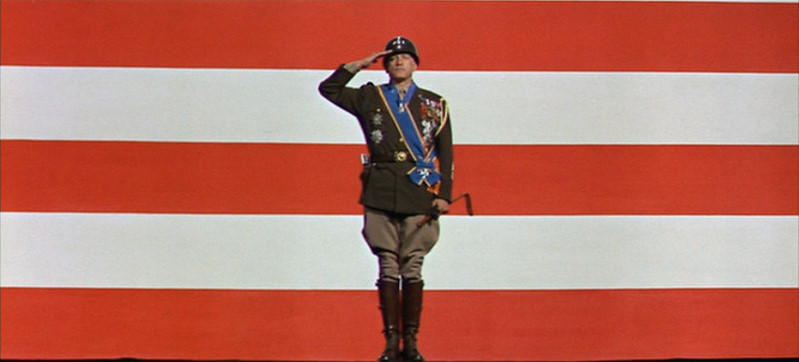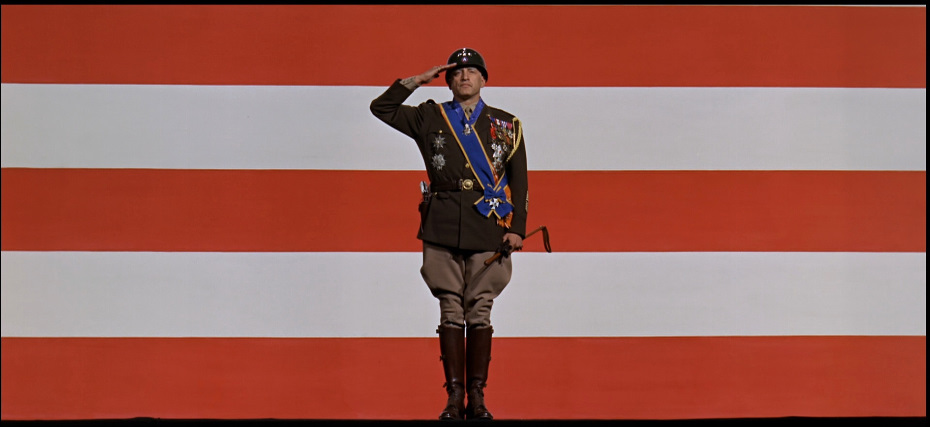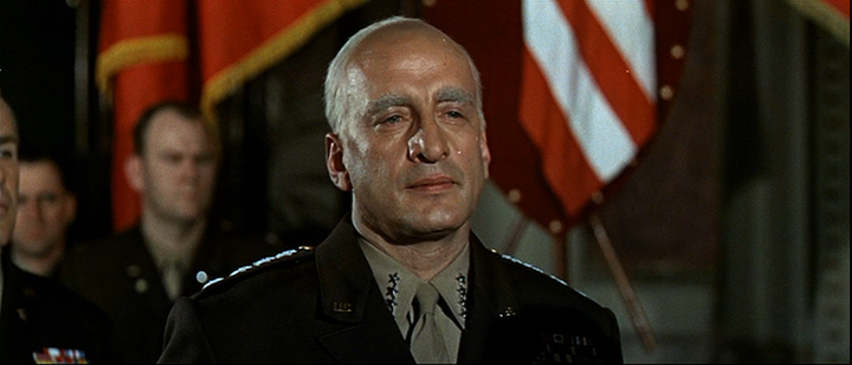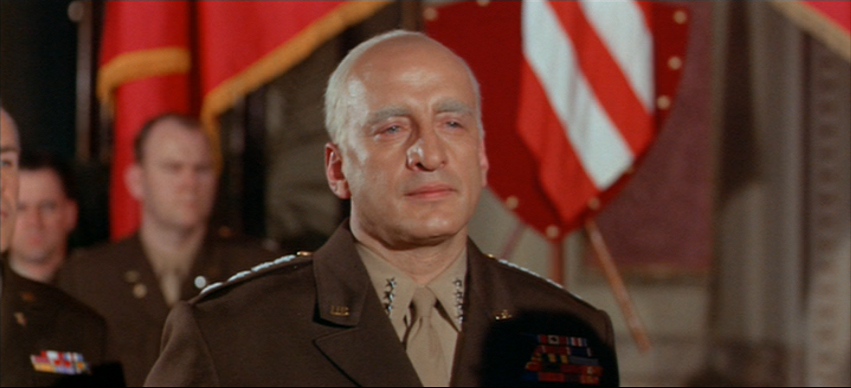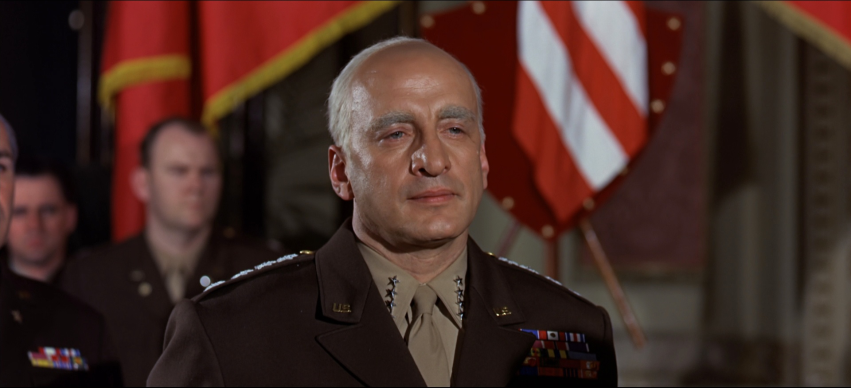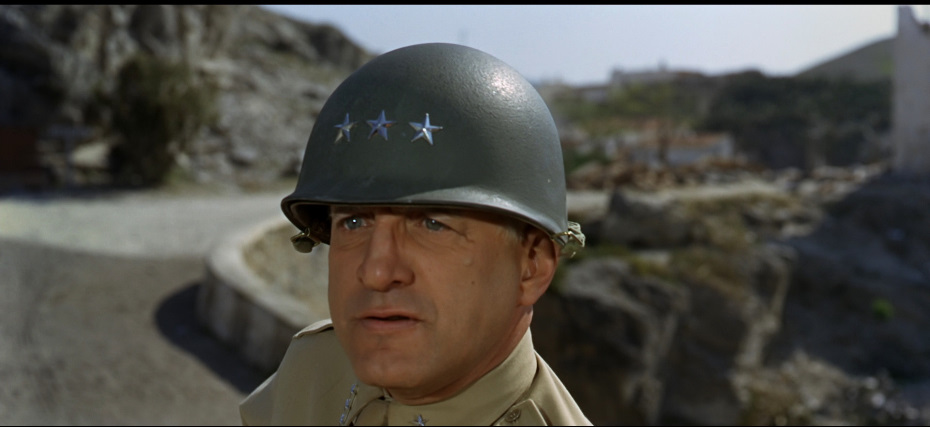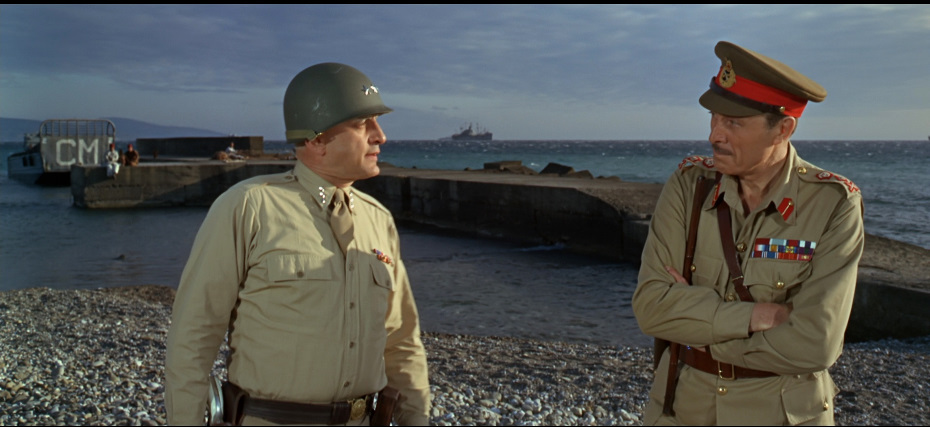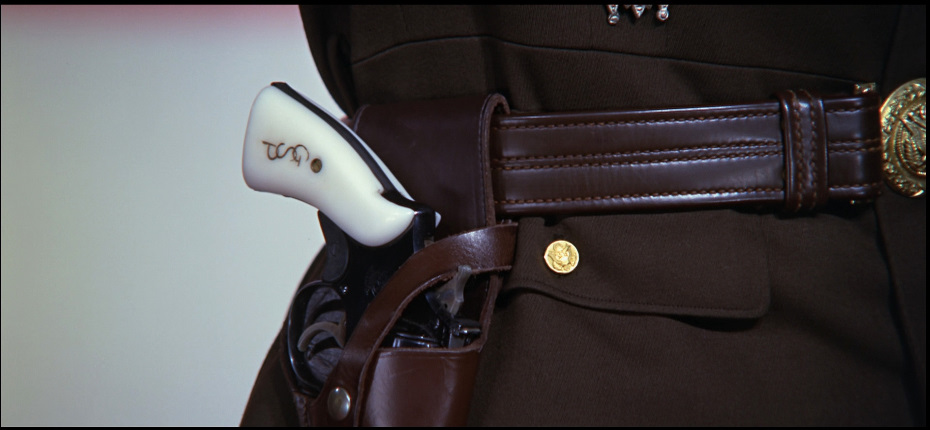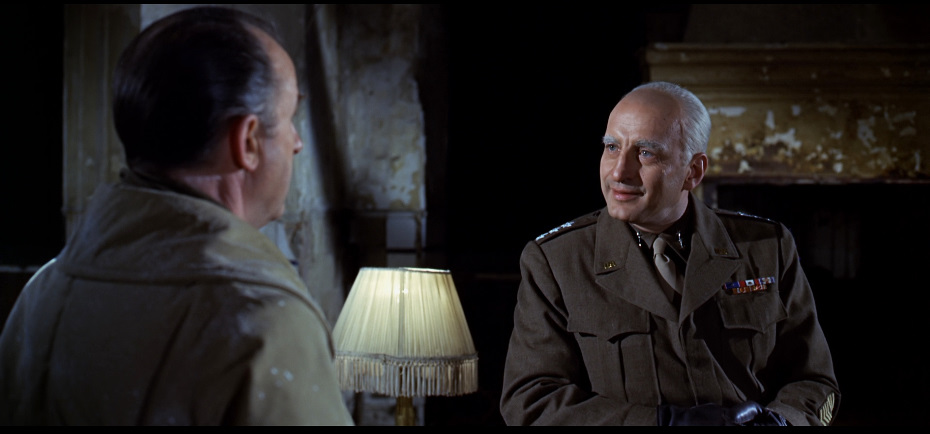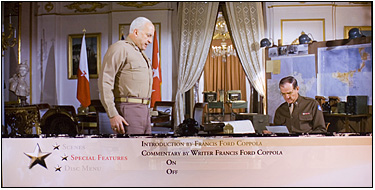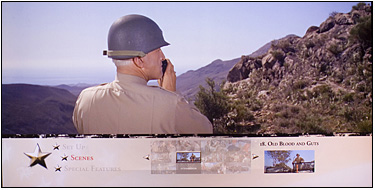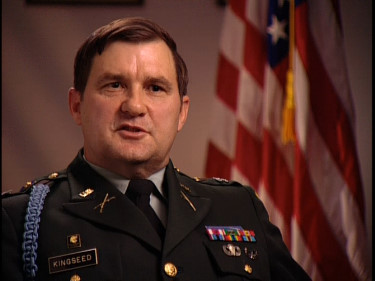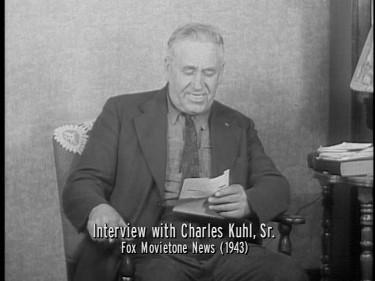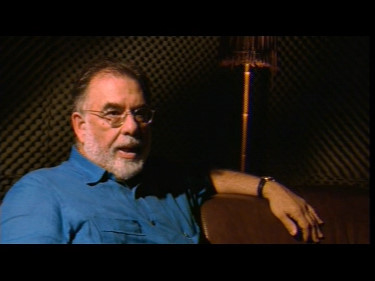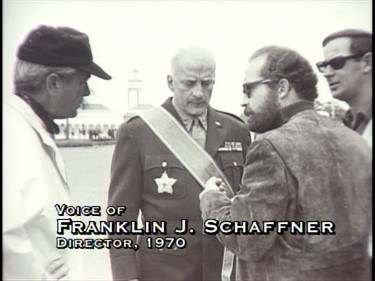The Fox Blu-ray War Bash 2008
"The perfect gift for Dad this Father's Day" - so says Fox for their
long-awaited series of five – count them – big budget war films from
their vast catalog:
Battle of Britain (1969),
A Bridge Too Far (1977),
The Longest Day
(1962),
Patton
(1970), and
The Sand Pebbles
(1966). Except for
The Sand Pebbles,
these are all WWII films. Three of them show off a huge cast of
luminaries, but only one (A Bridge Too Far) does it without undue
posturing. All of them have outstanding photography: even the least
successful as a script (Battle
of Britain)
has some terrific aerial photography.
Between the five, they scored nine Academy Awards, which is less
impressive when you consider that seven of them were for one picture
alone (Patton).
A Bridge Too Far,
which had zero nominations, has become, for me, one of the more
rewatchable WWII movies, and has one of the most engaging film scores
composed for the genre. Jerry Goldsmith's score for
Patton
was rightfully nominated, but lost to – are you sitting down for this –
Love Story!
The Longest Day
is remarkable for two reasons: it is one of the first films shot in Black &
White to be released on Blu-ray! (Bergman's
The Seventh Seal jumps to mind as another - there may be a few
more) and it is also one of the older films on the new format... and best
looking image – all the more surprising considering how bloody awful the
SD 2-disc Collector's Edition was. (The previous letterboxed image was
sharper, even after zoomed out to full size.) The sound tracks for all
of these movies are very good-to-excellent. They may not have the same
level of crunch we have come to expect since
Saving Private Ryan, but they are convincing all the same,
regardless of age. The music tracks for these films are especially
clear, invigorating and supportive of the mood.
All of the titles have seen SD-DVD incarnations previously, some very
good ones, some with extensive supplements. My comparison of the
supplements from the latest SD editions and the respective Blu-ray
reveals that all of the extra features – with the exception of
A Bridge Too Far
- are ported over to High Def. Except for the occasional trailer, there
are NO high-def extra features to be found on any of these new releases.
Two of them (A
Bridge Too Far and
Battle of Britain)
have no extra features at all, unless you count trailers (which I
don't.)
Battle of Britain
SD edition, by the way, is the sole movie of this quintet not too have
received the 2-disc treatment in 480i. The BRDs of
Patton
and
The Longest Day
are 2-disc affairs, but Fox opted for a single 50 GB disc to accommodate
all but "Road Show" version of the 2-disc material from their most
recent SD of
The Sand Pebbles.

|
Patton [Blu-ray]
(Franklin J. Shaffner,
1970)
Review by Leonard
Norwitz
Studio:
Theatrical: 20th
Century Fox Pictures
Home Entertainment
Blu-ray: 20th
Century Fox Pictures
Home Entertainment
Disc:
Region: 'A'-locked
(as verified by the
Momitsu region FREE Blu-ray player)
Runtime: 2:51:57.307
Disc Size: 39,487,428,332 bytes
Feature Size: 38,292,473,856 bytes
Video Bitrate: 22.95 Mbps
Chapters: 37
Case: Standard Blu-ray case
Release date: June 3rd, 2008
Video:
Aspect ratio: 2.20:1
Resolution: 1080p / 23.976 fps
Video codec: MPEG-4 AVC Video
Audio:
DTS-HD Master Audio English 3826 kbps 5.1 / 48 kHz / 3826
kbps / 24-bit (DTS Core: 5.1 / 48 kHz / 1509 kbps / 24-bit)
Dolby Digital Audio English 448 kbps 5.0 / 48 kHz / 448 kbps
Dolby Digital Audio English 224 kbps 2.0 / 48 kHz / 224 kbps
Dolby Digital Audio French 224 kbps 2.0 / 48 kHz / 224 kbps
Dolby Digital Audio Spanish 224 kbps 2.0 / 48 kHz / 224 kbps
Subtitles:
English (SDH), Chinese (traditional and simplified),
French, Spanish,
none
Extras:
• Disc 1:
Introduction by
Screenwriter Francis
Ford Coppola
• Disc 1: Audio
Commentary by
Francis Ford Coppola
• Disc 2:
Behind-the-Scenes
Still Gallery with
Audio Essay on the
Historical Patton
• Production Still
Gallery Accompanied
by Jerry Goldsmith's
Complete Musical
Score
• Original
Theatrical Trailer
• Documentaries:
• History Through
the Lens: Patton – A
Rebel Revisited
• Patton's Ghost
Corps
• The Making of
Patton
The Film:
9
An under thirty
Francis Ford Coppola
meant to satisfy
both hawks and doves
in his Oscar winning
screenplay. I didn't
know that until I
heard him say so in
the Introduction to
the movie, but I
shall thought he did
a fine job of just
that when I first
saw the film in
1970. When I learned
sometime later that
it was Nixon's
favorite movie, I
thought: Q.E.D.!
There is so much
already written
about this film –
Roger Ebert's fine
review
HERE: among
others. Also, Gary
has already covered
the basics in his
review of the SD and
the extra features
HERE so I
shall content myself
generally with
comments about the
image and sound.
Image:
8.5 (6~8.5/9)
NOTE:
The below
Blu-ray
captures were taken directly from the
Blu-ray
disc.
The
first number
indicates a relative
level of excellence
compared to other
Blu-ray video discs
on a ten-point
scale. The second
number places this
image along the full
range of DVD and
Blu-ray discs.
Comparison to Fox's
recent SD Cinema
Classics Collection
edition is what this
is all about, so
let's take a closer
look. We can see
some edge
enhancement on the
SD – not much, but
some. I found none
on the Blu-ray.
Proper edge
definition is
essential if we are
to tolerate, no less
enjoy, a film on
large screen
projection for three
hours. There is an
orange cast to the
SD, which is also
more saturated. The
BRD is a more open
picture: less
saturated – and
since it has very
little color cast,
it is more available
to more color
variation
scene-to-scene, and
within the frame.
Differences in
cropping are
insignificant.
Fox's Cinema
Classics DVD is
remarkable for the
degree of noise
reduction applied –
so much so that it
obliterates what
texture the previous
DVD offered. We can
see why the decision
was made to use DNR
– the grain was
bordering on noise.
The earlier DVD also
appears
oversharpened to my
eye. The Blu-ray, on
the other hand,
steers a middle
course in which DNR
is applied more
selectively. A wisp
of texture is still
obtained in jackets
(check out Malden's
jacket in his
close-up), but I
find that there is
too much smoothing
all around, and
Scott's face can get
seriously waxy in
several of the
shots. Even so,
there are benefits
in resolution and
dimensionality that
we come to expect
from high
definition.
CLICK EACH
BLU-RAY
CAPTURE TO SEE ALL IMAGES IN FULL 1920X1080 RESOLUTION
|
1) 20th Century Fox - Region 1 - NTSC TOP
2) 20th Century Fox (2-disc
Cinema Classics Collection) -
Region 1 - NTSC MIDDLE
3) 20th Century Fox - Region
'A' -
Blu-ray
BOTTOM |
Subtitle Sample: Not exact frame
|
1) 20th Century Fox - Region 1 - NTSC TOP
2) 20th Century Fox (2-disc
Cinema Classics Collection) -
Region 1 - NTSC MIDDLE
3) 20th Century Fox - Region 'A' -
Blu-ray BOTTOM
|
|
1) 20th Century Fox - Region 1 - NTSC TOP
2) 20th Century Fox (2-disc
Cinema Classics Collection) -
Region 1 - NTSC MIDDLE
3) 20th Century Fox - Region 'A' - Blu-ray
BOTTOM |
NOTE: These images are in the PNG format -
(Portable Network Graphics) is a bitmap image format that employs lossless
data compression. It is very large (file size) for us to use consistently.
These captures show
a greater prevalence
of the liberal DNR
(Digital Noise
Reduction)
Audio & Music:
7/9
I finally have what
should be a pretty
decent, though not
entirely finalized,
surround system in
place. It has not
yet been
professionally
calibrated. That may
be a few weeks off,
so regard my
comments with this
in mind – and if
there is the need
for qualification, I
shall post in the
Update section. In
any case, I feel I
am much closer to
the intentions of
the audio mix than
ever before.
My new surround
system captures the
subtlety of Jerry
Goldsmith's
unusually eerie
score and the
growlings of George
C. Scott's
alter-George but,
compared to what's
possible today,
artillery, machine
gun fire and bomb
blasts are not
nearly as convincing
as what is possible
today. Still, an
improvement over the
SD.
Operations:
6
Since we have Sir
Francis holding
forth in informative
tones on the
commentary, I don't
see any need for us
to have to deal with
him in the
unavoidable, but
skippable,
Introduction.
Whether you approach
the feature film by
hitting Play on the
Main Menu or from
Scenes, you gonna
have to deal with
Francis – and in a
pitiful 480i image,
to boot.
Extras:
7
One comment on the
Production Still
Gallery Accompanied
by Jerry Goldsmith's
Complete Musical
Score: I was
expecting either a
longer score (It's
only a little over
half an hour) or a
faster paced slide
show. I got neither.
Better heard and not
seen, at least not
at the same time.
Since I seem to be
on a tear about Mr.
Coppola's
Introduction, I
might as well add
that anything that
is an embedded
unavoidable feature
of the movie
shouldn't be listed
as an Extra Feature.
Bottom line:
8
Any fan of this
movie will want to
have the best
looking image.
Frankly, I didn't
expect all that
much, especially
after the level of
artificial smoothing
observed in the
Cinema Classics
edition. But Blu-ray
scores decently in
this despite the
injudicious use of
DNR, especially in
that we aren't
likely to see a new
video release of
this movie anytime
soon.
Leonard Norwitz
May 25, 2008
|
|
|

About the Reviewer: I first noticed that some movies were actually "films" back around
1960 when I saw Seven Samurai (in the then popular truncated version),
La Strada and
The Third Man for the first time. American classics were a later and
happy discovery.
My earliest teacher in Aesthetics was Alexander Sesonske, who encouraged the
comparison of unlike objects. He opened my mind to the study of art in a broader
sense, rather than of technique or the gratification of instantaneous events. My
take on video, or audio for that matter – about which I feel more competent – is
not particularly technical. Rather it is aesthetic, perceptual, psychological
and strongly influenced by temporal considerations in much the same way as
music. I hope you will find my musings entertaining and informative, fun,
interactive and very much a work in progress.
The LensView Home Theatre:
BLU-RAY STORE
ALL OUR NEW FORMAT DVD REVIEWS

|
|

|
![]()

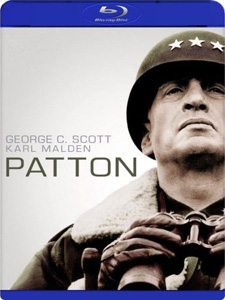
_Patton_BRD.jpg)
.jpg)
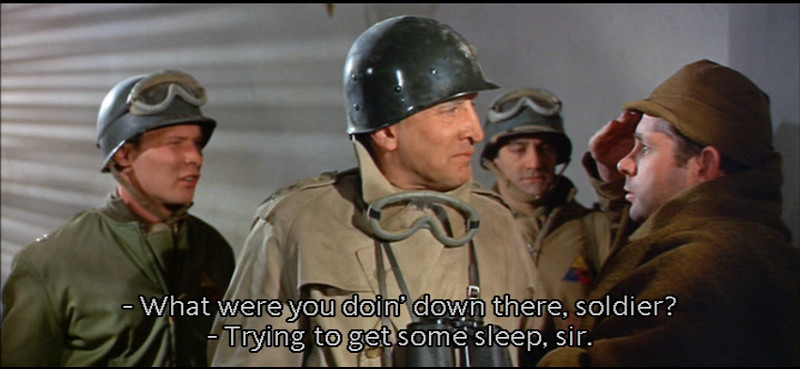
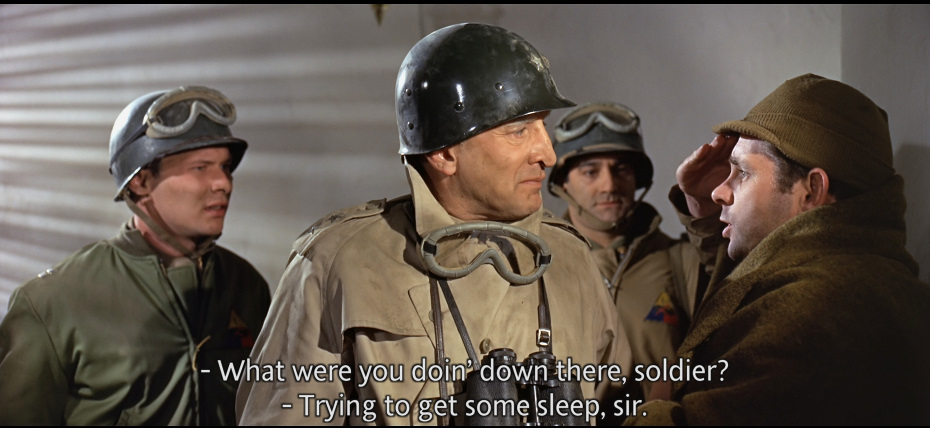
.jpg)
